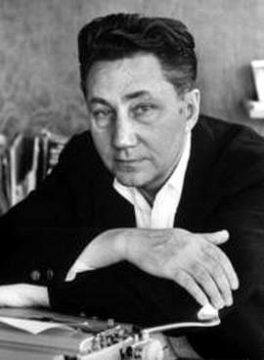Davis Steensma in JCO:
 Peter De Vries (1910–1993)—writer for the New Yorker, Poetry editor, once widely acknowledged as the top American comic novelist of his era—was best known for his clever wordplay, irreverent humor, and extended riffs on a broad range of human foibles.1–3 But despite De Vries’ reputation for puckish wit and for the skewering bon mot, his greatest novel is a tragedy—one that is all the more haunting because it is stuffed with autobiographical detail. The Blood of the Lamb, 4 published in 1961, describes the growing estrangement of the main character (Don Wanderhope) from his origins in a close-knit, blue-collar, Chicagoland Dutch immigrant community. The death of a sibling, parental mental illness, and the strains of a volatile marriage contracted too hastily were heavy stones that stressed the increasingly rickety structure of Wanderhope’s boyhood religious faith, until that faith finally collapsed beneath the crush of a singular and devastating loss, re-emerging as something more ambiguous. Emily De Vries—her literary counterpart is Carol Wanderhope—De Vries’ youngest child and a chief existential consolation, died in September 1960, just a few days before her 11th birthday and 2 years after she was diagnosed with acute lymphoblastic leukemia (ALL).1
Peter De Vries (1910–1993)—writer for the New Yorker, Poetry editor, once widely acknowledged as the top American comic novelist of his era—was best known for his clever wordplay, irreverent humor, and extended riffs on a broad range of human foibles.1–3 But despite De Vries’ reputation for puckish wit and for the skewering bon mot, his greatest novel is a tragedy—one that is all the more haunting because it is stuffed with autobiographical detail. The Blood of the Lamb, 4 published in 1961, describes the growing estrangement of the main character (Don Wanderhope) from his origins in a close-knit, blue-collar, Chicagoland Dutch immigrant community. The death of a sibling, parental mental illness, and the strains of a volatile marriage contracted too hastily were heavy stones that stressed the increasingly rickety structure of Wanderhope’s boyhood religious faith, until that faith finally collapsed beneath the crush of a singular and devastating loss, re-emerging as something more ambiguous. Emily De Vries—her literary counterpart is Carol Wanderhope—De Vries’ youngest child and a chief existential consolation, died in September 1960, just a few days before her 11th birthday and 2 years after she was diagnosed with acute lymphoblastic leukemia (ALL).1
Through the filter of his prodigious literary gifts, De Vries poured out the monstrous, idiosyncratic grief of a bereft father, of a man who has lost something that really matters. The Blood of the Lamb was published just a year after Emily’s death, and the rawness of emotion sears its pages: often bitter, sometimes elegiac, and with scattered patches where the writing is less polished, less subtle than is typical for De Vries.4 The author’s seething anger over the unfairness of the world is frequently channeled into frustration at a paternalistic and ultimately impotent medical establishment, which provided plenty of facile reassurances, even as it failed to save his innocent “lamb” of a daughter from her own poisoned blood.
De Vries eventually returned to writing comic novels after The Blood of the Lamb, but always with darker undertones, echoing the futility and chaotic meaninglessness of life that he felt so acutely during Emily’s terminal illness.1,2 These stylistic changes parallel the intellectual evolution of Charles Darwin a century earlier, after a similar event: Darwin lost his beloved daughter Annie in 1851, also at age 10 years from an unexplained illness—possibly tuberculosis, which was just as frightening and incurable in the 1850s as leukemia a century later.5 Darwin’s great-grandson suggests that the feelings of randomness and lack of ultimate purpose engendered by Annie Darwin’s untimely death pushed the great naturalist towards a reluctant full acknowledgment of the terrifying metaphysical implications of his mechanism of natural selection.5,6 The legacy of a child’s premature death can be long indeed.
More here. (Note: An old novel worth re-reading. Thanks David.)
